A mid-air collision was barely avoided over the skies of Somalia following a miscommunication from Air Traffic Control (ATC) on February 24. This incident involved a Qatar Airways Boeing 787-8 and an Ethiopian Airlines Airbus A350-900.

Incorrect Instructions
A Qatar Airways Boeing 787-8 was cruising over the Gulf of Aden en route from Doha (DOH) to Entebbe, Uganda (EBB). The flight was QR 1383, with the plane having registration A7-BCN. Flying in the opposite direction around the same time was an Ethiopian Airlines Airbus A350-900 flying from Addis Ababa (ADD) to Dubai (DXB). Ethiopian was operating flight ET 602, with the aircraft having registration ET-ATY.
QR 1383 was cruising at 38,000 feet (11,582 meters). As it entered Somali airspace, controllers in Mogadishu instructed the flight to climb to 40,000 feet (12,192 meters). Reports suggest that this instruction was made around 12:32 p.m. local time. Right then, the Ethiopian A350 was cruising at 39,000 feet (11,887 meters), flying in the opposite direction.
.png)
Following the controllers' instructions, QR 1383 began climbing to 40,000 feet (12,192 meters), or Flight Level 400. This maneuver put the aircraft on a collision course right in the path of ET 602.
Thankfully, all modern aircraft have a Traffic Collision Avoidance System (TCAS). This system notifies the pilots if their aircraft is flying dangerously close to another plane and if a collision is imminent. Thanks to TCAS issuing an urgent warning on both aircraft, the pilots could take immediate corrective action, thus preventing a devastating mid-air collision.

Aftermath
The Somali Civil Aviation Authority (SCAA) is investigating this incident, which could have been worse due to a simple miscommunication. SCAA said in an official statement: "The planes were at a dangerous distance from each other but the equipment attached to the two planes was saved." In other words, TCAS saved both aircraft from colliding with each other.
Somalia's CAA is currently determining the root cause of this miscommunication between the Mogadishu air traffic controllers and the Qatar Airways 787 pilots. Furthermore, this incident highlights various concerns regarding the region's airspace management.
Somalia's Ministry of Transport and Civil Aviation, along with the Federal Government, have previously expressed concerns regarding flight path disruptions in the northern regions of Somaliland. SCAA has accused Somaliland of allegedly exacerbating these risks by "misdirecting aircraft," showing the dire need for better communication and protocols within the region's air traffic control.

Somaliland, not to be confused with Somalia, is recognized internationally as a de jure part of the Federal Republic of Somalia. While it is an autonomous region that declared independence in 1991, no foreign power has recognized this move. When the incident occurred, the Ethiopian and Qatar Airways flights passed near Somaliland's capital, Hargeisa.
While the ATC incident is currently considered a simple miscommunication, SCAA is still investigating it. Such disruptions pose a navigational issue for pilots and significant risks to air traffic. This especially highlights the potential dangers and lack of coordination plaguing the region. Both continued to their destinations safely.
KAL858: The North Korean Bombing that Shocked the World » How Drone Swarms Rewrote the Rules of Aviation » Lufthansa Technik Unveils Major ACJ318 Elite Upgrade Program »
Comments (0)
Add Your Comment
SHARE
TAGS
NEWS Somalia Qatar Airways Ethiopian Airlines Somaliland Incident Near-Collision Airbus A350-900 Boeing 787-8 Dreamliner SafetyRECENTLY PUBLISHED
 interCaribbean Airways Expands Barbados Hub with Five New Non-Stop Routes
In a significant move to solidify its position as the premier regional connector, interCaribbean Airways has officially announced a major network expansion from its Southern Caribbean hub at Grantley Adams International Airport (BGI). Starting March 8, 2026, the airline will launch five new non-stop routes, bringing its total number of direct destinations from Barbados to 12.
ROUTES
READ MORE »
interCaribbean Airways Expands Barbados Hub with Five New Non-Stop Routes
In a significant move to solidify its position as the premier regional connector, interCaribbean Airways has officially announced a major network expansion from its Southern Caribbean hub at Grantley Adams International Airport (BGI). Starting March 8, 2026, the airline will launch five new non-stop routes, bringing its total number of direct destinations from Barbados to 12.
ROUTES
READ MORE »
 Alaska Airlines and LATAM Formally Dissolve Codeshare Partnership
Marking the end of an era in Pan-American aviation, Alaska Airlines has officially terminated its nearly decade-old codeshare and loyalty partnership with LATAM Airlines Group. The split, finalised in a formal filing to the U.S. Department of Transportation (DOT) on December 29, 2025, follows a phased winding down of reciprocal benefits that began earlier in the autumn.
NEWS
READ MORE »
Alaska Airlines and LATAM Formally Dissolve Codeshare Partnership
Marking the end of an era in Pan-American aviation, Alaska Airlines has officially terminated its nearly decade-old codeshare and loyalty partnership with LATAM Airlines Group. The split, finalised in a formal filing to the U.S. Department of Transportation (DOT) on December 29, 2025, follows a phased winding down of reciprocal benefits that began earlier in the autumn.
NEWS
READ MORE »
 Global Drone Wingman Programs Accelerate Toward Critical 2026 Milestones as Competition Intensifies
The race to field operational autonomous "loyal wingman" drones is accelerating into overdrive as 2026 approaches, with the United States Air Force poised to make critical production decisions, Australia demonstrating combat capabilities with live weapons, and rival programs in Europe and Asia rapidly maturing.
NEWS
READ MORE »
Global Drone Wingman Programs Accelerate Toward Critical 2026 Milestones as Competition Intensifies
The race to field operational autonomous "loyal wingman" drones is accelerating into overdrive as 2026 approaches, with the United States Air Force poised to make critical production decisions, Australia demonstrating combat capabilities with live weapons, and rival programs in Europe and Asia rapidly maturing.
NEWS
READ MORE »



